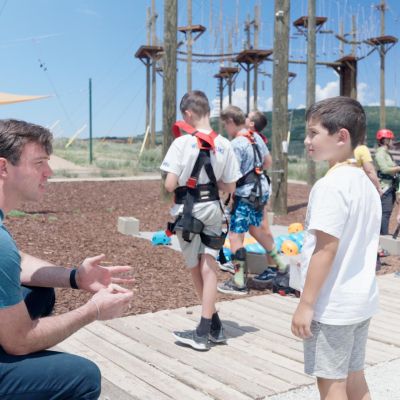As an occupational therapy student passionate about promoting inclusivity and independence, I am excited to share the world of adaptive recreation in this blog. Join me on a journey exploring the transformative power of adaptive sports and leisure activities in enhancing the quality of life for individuals with diverse abilities. Through exploring different types of equipment and activities, community aspects, and accessible environments, let’s uncover the profound impact of adaptive recreation on physical, emotional, and social well-being.
Adaptive recreation is a transformative approach to recreational activities. By adjusting equipment, teaching methods, and services to accommodate someone’s disability, we ensure everyone can participate. At the National Ability Center, we believe in the power of inclusivity, recognizing that recreation goes beyond just enjoyment – it significantly impacts mental health, confidence, and self-esteem. Scientific evidence supports the notion that engaging in adaptive recreation can be a game-changer, especially for individuals with disabilities.
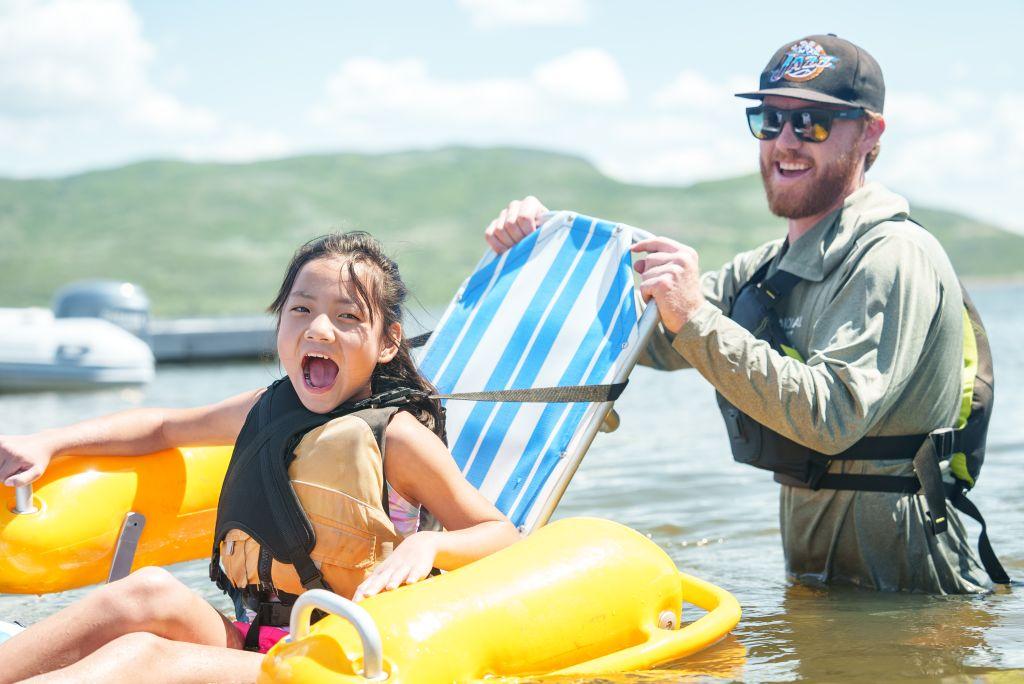
Benefits of Adaptive Recreation
Studies consistently highlight adaptive recreation’s positive impact on physical and mental health. Participating in recreational activities has been linked to reduced stress, improved mood, and enhanced overall well-being. For individuals with disabilities, these benefits extend even further. A study by Diaz et al. concluded that “Adaptive sports can provide an avenue to continue to optimize physical fitness but can also positively impact quality of life” (2019). Engaging in adaptive recreation contributes to physical fitness by enhancing cardiopulmonary and cardiovascular health, often challenged by disability (Filipcic et al., 2021). In addition, engaging in enjoyable and fulfilling activities contributes to “positive outcomes on self-esteem, body image, self-perceived quality of life, self-efficacy, community reintegration, employment, and motivation” (Diaz et al., (2019). It becomes a powerful tool for holistic well-being, proving that recreation is not a luxury but a vital aspect of a fulfilling life.
Check out the impact of adaptive recreation at the National Ability Center on our website!
Inclusive Design and Accessibility
At the National Ability Center, we prioritize inclusive design and accessibility to ensure everyone can participate. Adaptive equipment and teaching methods play a crucial role in breaking down barriers. Take adaptive skiing, for example – specialized equipment like sit skis or outriggers allows individuals with mobility challenges to experience the thrill of gliding down the slopes. Similarly, indoor climbing gyms with adaptive harnesses and counterbalance systems open mountains of opportunities for those with disabilities.
Adaptive Ski and Snowboarding
Adaptive ski and snowboarding equipment are tailored to accommodate various physical and cognitive challenges. These specialized tools enable people with disabilities to slide on the snow confidently.
Bi-Ski
- For someone who has a mobility impairment, a bi-ski provides a stable base while having an enjoyable experience in the snow.
- A bi-ski consists of a seat mounted on a set of skis to allow for a smooth ride down the slopes.
- It features two specially designed skis attached to a frame with a bucket-style seat.
- Bi-skis are beneficial for individuals with missing lower limbs, spinal cord injuries, cerebral palsy, or other conditions that affect lower body mobility.
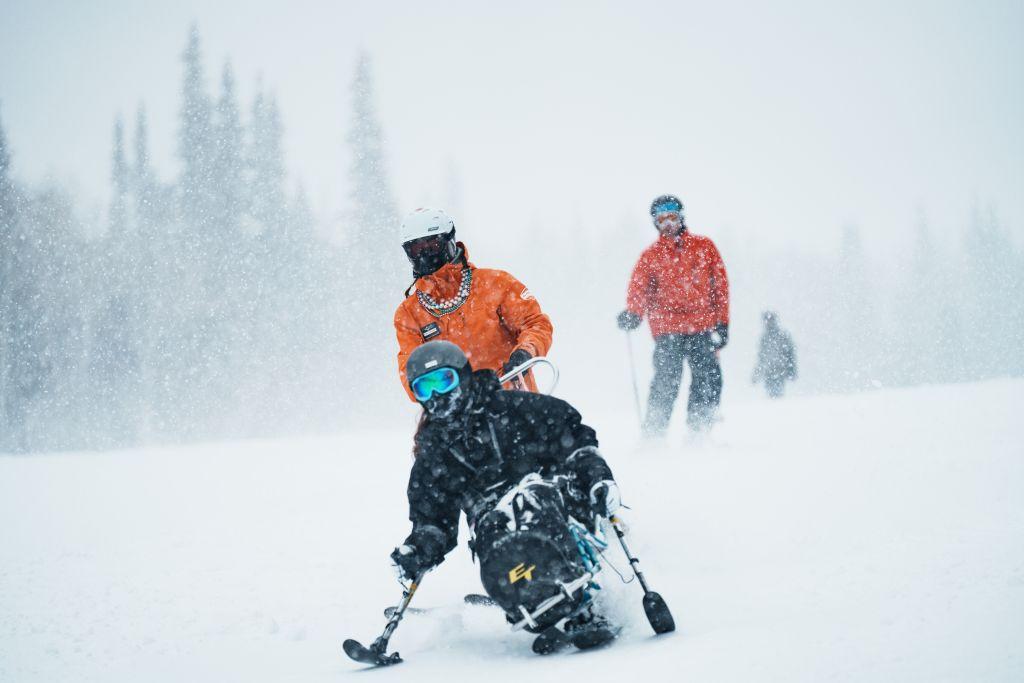
Mono-Ski
- A mono-ski is a progressive step up from the bi-ski, allowing skiers to navigate more challenging terrain.
- It consists of a bucket with a single ski attached to the frame.
- A mono-ski is often used by high-performance competitive athletes with spinal cord injuries, lower limb amputations, or other conditions affecting lower body function.

Similarly, a bi-skier and a mono-skier utilize outriggers—short poles with ski tips—for balance and steering that provide additional stability and control. These types of skis provide an opportunity to enjoy the excitement of skiing while promoting inclusivity and accessibility in winter sports.
Slider
- A slider provides a unique and versatile approach to adaptive skiing that allows a person with a disability to ski in an upright position.
- The slider ski system consists of an arm platform on skis to support the upper body, while the lower body is supported on regular 2-track skis.
- This adaptive equipment is best suited for an individual with hemiparesis (muscle weakness or paralysis on one side of the body) due to a stroke or mobility impairment.

Ski Bike
- A ski bike combines the elements of skiing and biking.
- This equipment consists of a frame with skis rather than wheels, a seat for the rider, and handlebars for steering.
- Often, a person riding a ski bike will wear short skis on the bottom of their feet to assist with stability while allowing for a smooth glide down the slopes.
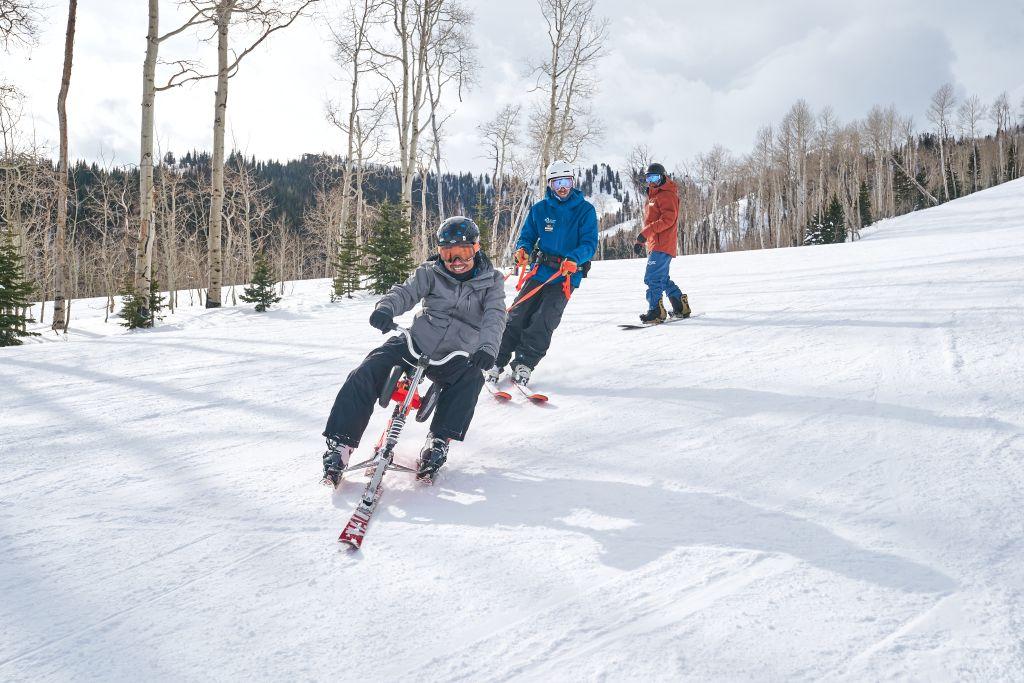
Snowboarding
- Adaptive snowboarding embraces unique designs customized to fit the specific needs of an athlete with lower limb impairment.
- A para snowboard possesses adaptive features, including bindings or attachments to secure the rider’s feet or prosthetics and modifications to the board for better stability and control.
- The equipment is adapted to accommodate various impairments, including lower limb disabilities or amputations.

Discover the joy of adaptive skiing and snowboarding at the National Ability Center’s McGrath Mountain Center in Park City, Utah. Check out this link here to learn more about adaptive skiing and snowboarding.
Adaptive Climbing
Adaptive climbing at the National Ability Center provides a unique experience for people with disabilities to conquer new heights and challenge their cognitive and physical strength. Through specialized systems, the National Ability Center allows people of all abilities to participate in an adventurous activity pushing beyond their limitations.
Mechanical Advantage System
- A mechanical advantage system for adaptive climbing is a piece of equipment designed to assist climbers with limited strength or mobility in ascending a rope.
- These devices use mechanical principles to reduce the climber’s effort, making it easier to navigate vertical terrain.
Seated Harness
- A seated harness provides extra support and safety for individuals with a disability who may require more trunk and core stability when climbing.
- It features a padded seat, a back sling, adjustable straps, and attachment points for the climbing gear to allow the individual to climb in a comfortable seated position.
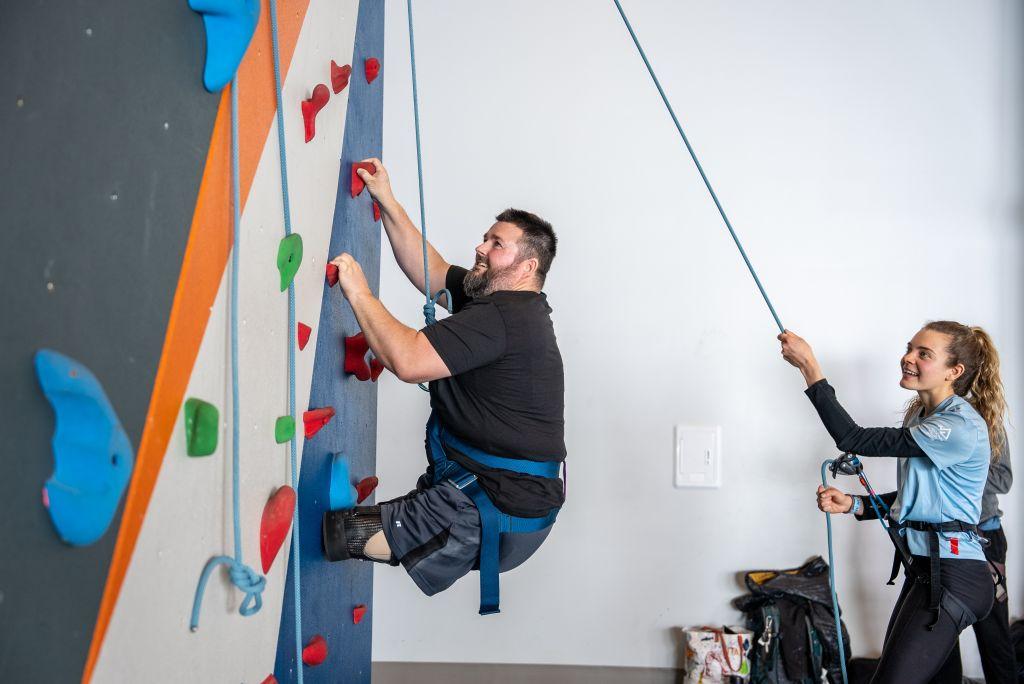
Boost your confidence and determination by climbing with us! Learn more about the National Ability Center’s indoor and outdoor climbing program here.
Adaptive Cycling
The National Ability Center offers adaptive cycling programs in both the summer and winter months. Whether you love to ride on snow or dirt, we provide specialized adaptive bikes and equipment tailored to accommodate various physical and cognitive challenges, allowing participants to explore the scenic trails right in our backyard and beyond.
Our fleet of adaptive bikes includes handcycles, recumbent trikes, tandem bikes, and more, ensuring that everyone can find a cycling option that suits their needs and preferences. Our trained staff members assist participants in selecting and adjusting the appropriate equipment to provide comfort and safety.
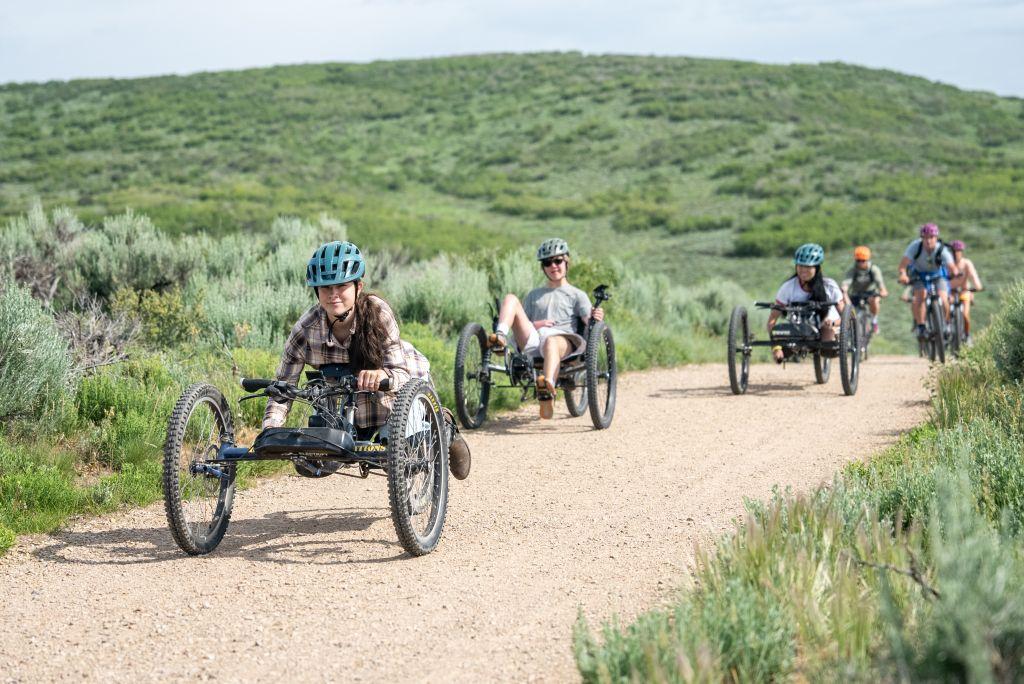
Handcycle
- This equipment is most beneficial for an individual with lower limb loss or a spinal cord injury because you pedal the bike with your hands.
Recumbent bike
- A recumbent bike is a three-wheeled valuable bike for individuals who experience a balance impairment, one-sided weakness, or loss of an upper limb on one side.
Tandem
- A tandem bike allows a person with a visual impairment to ride with a guide, allowing them to navigate the trails safely.
One of the best parts about adaptive sports is that it is all about what works best for you. Just because you have a specific diagnosis or disability does not mean you must ride a specific piece of adaptive equipment. The knowledgeable staff at the National Ability Center matches equipment for your individual needs. For example, one person who has a traumatic brain injury may have completely different symptoms compared to another person with a traumatic brain injury. Your unique abilities are considered when matching up the right piece of equipment for you.
Check out our What Is Adaptive? series on Instagram to learn more about adaptive equipment and teaching methods!
Building Community and Empowerment
Adaptive recreation is not just about activities; it’s about building a supportive community. National Ability Center instructor Jane Hudson states she loves working in adaptive recreation because she “loves being encouraged by the people around her. Being a part of the “I did it” moment is so rewarding.” Social connections are integral to our well-being, and adaptive recreation provides a platform for individuals to come together, share experiences, and form lasting bonds. Adaptive sports leagues, group outings, and community events create spaces where everyone feels welcome.
Addressing stigmas and misconceptions is also fundamental in creating an inclusive community that upholds the inherent right of people with disabilities to enjoy the great outdoors. To break down these barriers, we need to engage in open conversations that encourage understanding and empathy. By actively involving people with disabilities in the planning and execution of recreational spaces, we promote firsthand experiences that challenge outdated stereotypes. Education is a powerful tool in enabling a more inclusive mindset within the community and transforming recreational spaces into environments where diversity is celebrated. The goal should always be to ensure individuals with disabilities feel empowered to embrace the outdoors without reservation or hesitation.

Adaptive equipment makes recreation possible, but accessible indoor and outdoor spaces level the playing field. Consider your local mountain bike trails. Are they wide enough to fit a handcycle? Does the parking lot have accessible parking spaces and a ramp leading up to the trails? We must recognize the importance of designing recreational spaces to accommodate individuals with mobility impairments. These adaptations not only make recreation possible but also redefine what’s achievable.
Adaptive recreation is a gateway to a world of possibilities, offering benefits that extend beyond the physical realm. The National Ability Center is committed to empowering people with disabilities through adaptive recreation, growing the #AdaptiveNation, and building a community where everyone can thrive. Whether you choose to participate, volunteer, or support our mission, your involvement makes a difference. Join us in unlocking the power of adaptive recreation and creating a more inclusive and empowered world for all.
Written By:
Josie Svoboda | Occupational Therapy Doctoral Student
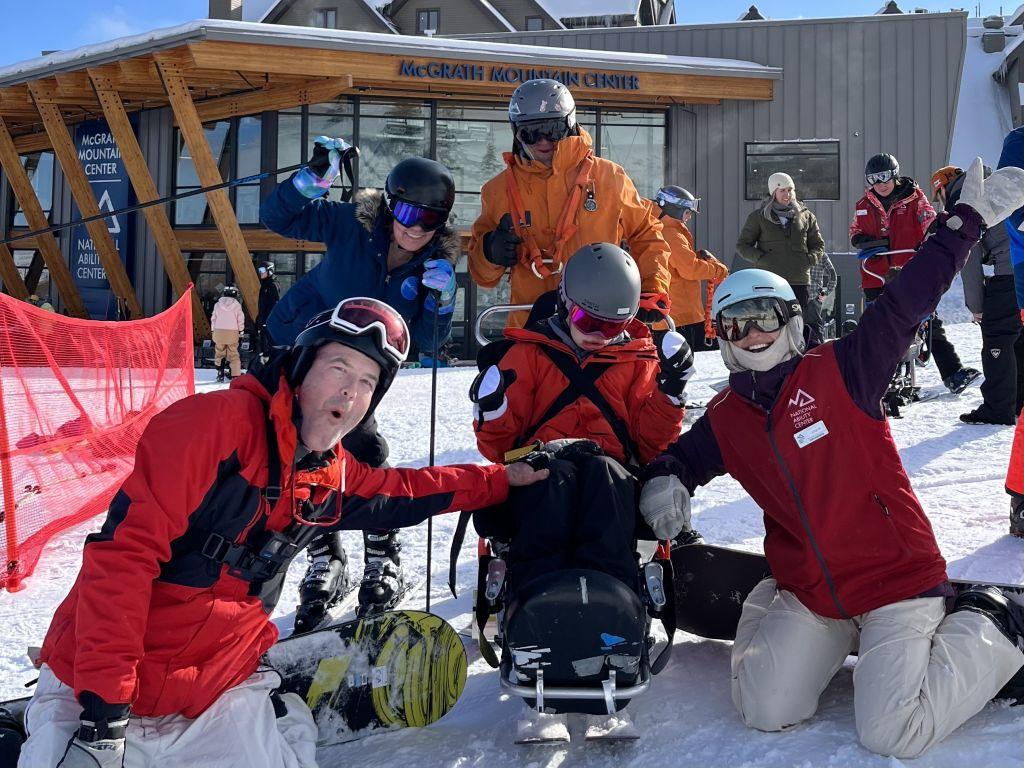
Resources:
Diaz, R., Miller, E. K., Kraus, E., & Fredericson, M. (2019). Impact of Adaptive Sports Participation on Quality of Life. Sports medicine and arthroscopy review, 27(2), 73 82. https://doi.org/10.1097/JSA.0000000000000242
Filipcic, T., Sember, V., Pajek, M., & Jerman, J. (2021). Quality of Life and Physical Activity of Persons with Spinal Cord Injury. International journal of environmental research and public health, 18(17), 9148. https://doi.org/10.3390/ijerph18179148




